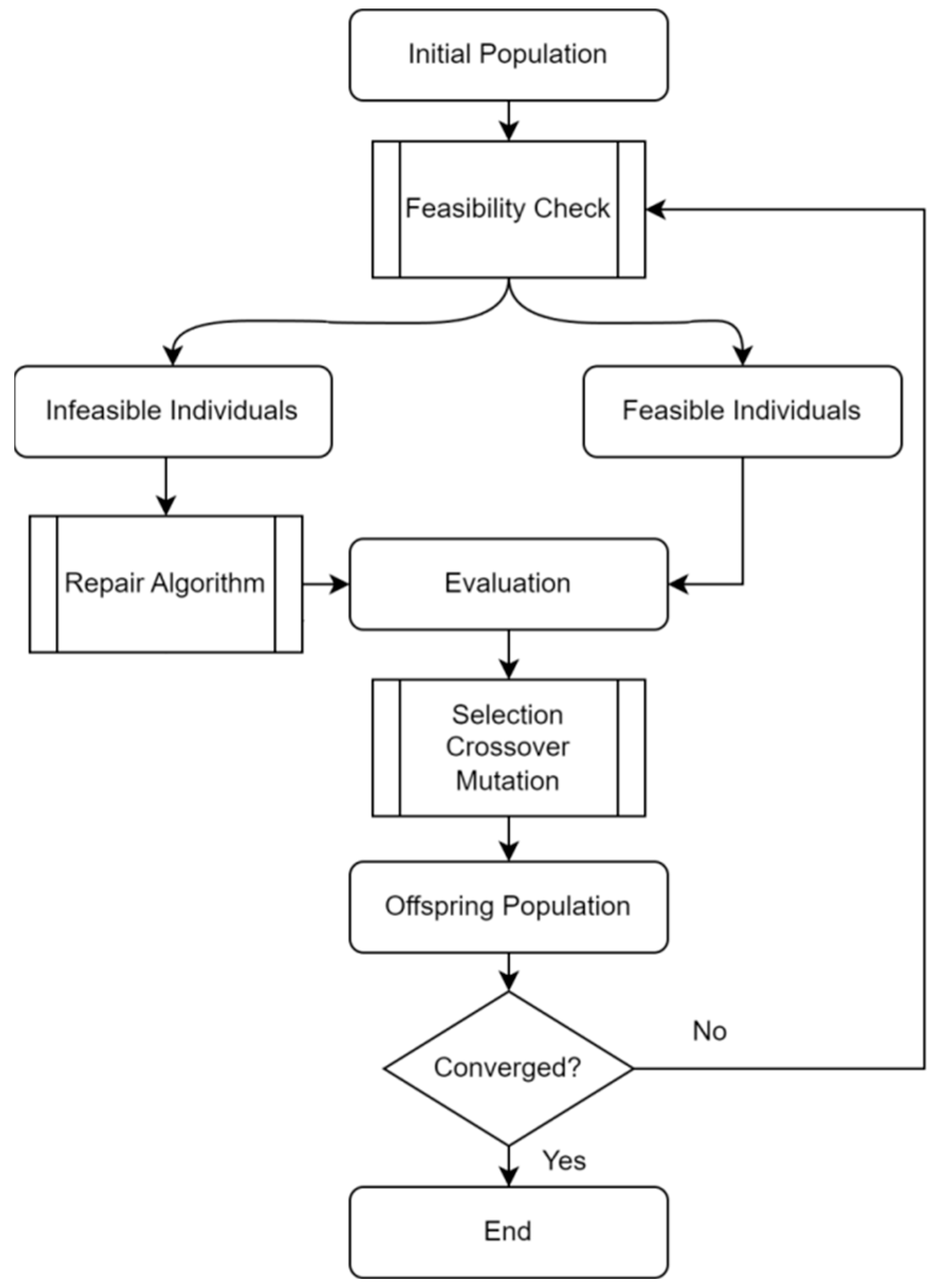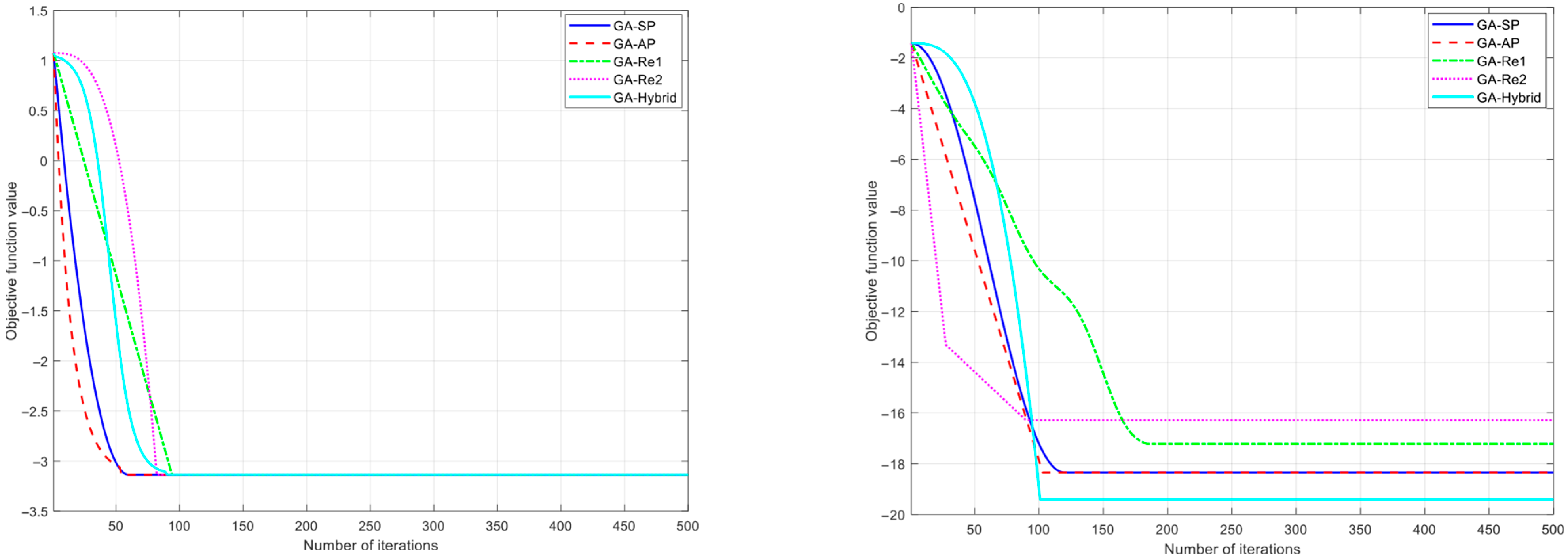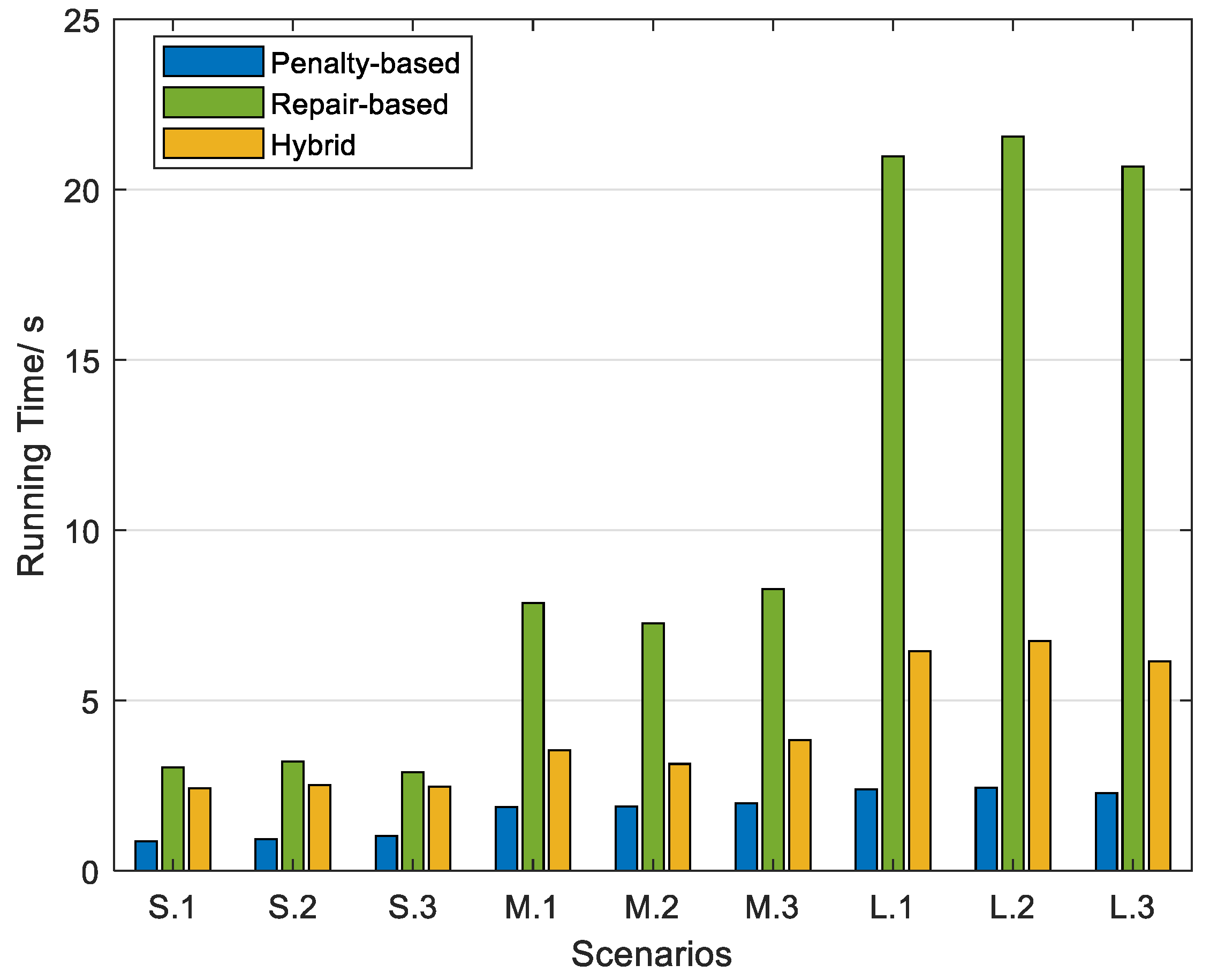4.1. Comparative Experiments
In order to validate the performance of our method, we tackle a set of target assignment problems of UAV swarms of varying sizes. The main characteristics of the experimental problems are reported in
Table 1, which includes three small-size scenarios (S.1, S.2, and S.3), three middle-size scenarios (M.1, M.2, and M.3), and three large-size scenarios (L.1, L.2, and L.3). The network size is indicated by
, where N and M denote the number of UAVs and the number of targets, respectively. In each scenario, we configured 10 threat sources, with their positions and threat radii generated randomly. In general, as the problem size increases, the size of the search space, the number of constraints (denoted by C), and the number of decision variables also tend to increase, resulting in an increase in the difficulty of the optimization problem. In addition, for constrained optimization problems, the ratio between the size of the feasible search space and that of the entire search space can also be considered as an indicator of the difficulty of the optimization problem. In our experiment, such a ratio is approximated by
, where
is the number of randomly generated individuals, and
is the number of feasible individuals out of these random ones. In this experiment, we set
to be 10,000.
Table 1, displaying a feasibility ratio of 0 across all instances, implies the inherent difficulty in solving the optimization problem under investigation.
In each experimental instance, a specified number of UAVs and targets are randomly generated in the virtual battlefield represented by a grid map. Additionally, a certain number of threat sources (including their positions and threat radii) are also randomly generated. Algorithm A* is employed to yield the trajectory from each UAV to each target, so that we can obtain the length of each trajectory. To encourage a more balanced assignment and prevent certain targets from being favored by a majority of UAVs, the setting of target values follows the following principle: the value of each target is directly proportional to its average distance to all UAVs. Values of both trajectory length and target value are normalized by the corresponding maximum and minimum. Unless otherwise specified, the weight in (6) is assumed to be 0.5 by default.
In this experiment, we will refer to the proposed method as GA_Hybrid, since both a penalty function and a repair heuristic are used to handle the constraints. We compare GA_hybrid with the following four competitors:
- ➢
GA_SP: GA where a static penalty function is used to handle constraints.
- ➢
GA_AP: GA where an adaptive penalty function is used to handle constraints.
- ➢
GA_Re I: GA where greedy repair is used to handle constraints; when encountering an unrepairable individual, replacing it with the best feasible individual.
- ➢
GA_Re II: GA where greedy repair is used to handle constraints; when encountering an unrepairable individual, replacing it with a random feasible individual.
To ensure fairness, the parameter settings of GAs in all compared methods remain identical. Specifically, we set the following: population size , roulette wheel selection, one-point crossover operator with a probability , probability of mutation , and the maximum number of generations to 500. Every algorithm is run 30 times, and the best results are recorded. Note that the impact of these parameters will not be further investigated in this paper.
Table 2 shows the results of all of the compared methods. A notable result is that the proposed GA_hybrid achieved the best result in all simulated instances. The GA with a static penalty could not obtain feasible solutions on the four largest-size instances, whereas an adaptive penalty improved the results of GA_SP in the M.3 instance. Although two repair heuristics could obtain feasible solutions in all instances, the quality of their solutions was poor, especially that of GA_Re II.
Hybrid vs. Pure penalty: By comparing GA_Hybrid with GA_SP and GA_AP, we find that the advantages of our method become increasingly prominent as the problem size increases. For three small-size instances, the results of these three methods are consistent. With an increase in the problem size, it becomes more difficult for GAs with penalty functions to find feasible solutions. However, we should note that the adaptive penalty may be an effective way of alleviating such a problem. The fundamental reason for the issue with penalty functions is an excessive number of constraints. In the proposed GA_Hybrid, we transform the constraints on targets into the objective function to play the role of soft constraints, which are handled by the penalty function. The remaining hard constraints (i.e., constraints on UAVs) are handled by the proposed repair heuristic. Such a combination can effectively address the aforementioned problem because the number of constraints assigned to the penalty function significantly decreases. Actually, the penalty function in either GA_SP or GA_AP needs to handle N + M constraints, whereas that in GA_Hybrid only needs to handle M constraints. It is noteworthy that the value of N is usually larger than M. Based on this comparison, it is apparent that employing solely a penalty function could be a viable option for instances with modest dimensions. However, its efficacy diminishes with an escalating number of constraints. In contrast, the proposed hybrid constraint-handling method, amalgamating the penalty function with the repair heuristics, is more inclined to unearth superlative feasible solutions of exceptional quality.
Hybrid vs. Pure repair: By observing the results of GA_Re I, GA_Re II, and GA_Hybrid, we find that the proposed hybrid constraint-handling method is more effective than that using solely a repair heuristic, especially in instances of larger sizes. For two small-size instances (S.1 and S.2), these three methods obtain the same solution. This outcome indicates that when the constraints are relatively simple, employing only the repair heuristic can yield satisfactory results. With the increasing complexity of constraints, there is a rising proliferation of unrepaired individuals, rendering it arduous to attain favorable outcomes, regardless of whether random or optimal feasible individuals are employed for replacement. However, the proposed hybrid method effectively avoids such occurrences. By separating the original optimization problem’s constraints into two sets, namely hard constraints and soft constraints, the repair heuristic only needs to handle the hard constraints. Compared to the original problem, this significantly reduces the complexity of repair as there is no need to consider the coupling relationship between the two sets of constraints. By comparing GA_Re I with GA_Re II, an intriguing finding emerges: replacing unrepaired individuals with random feasible individuals often leads to the discovery of superior solutions, as opposed to replacing them with the best individuals. The reason for this is that when a significant portion of the population consists of unrepaired individuals, replacing them with the best individuals often leads to getting trapped in local optima. Additionally, we have also observed that one advantage of using the repair heuristic to handle constraints is that it always manages to find feasible solutions, regardless of their quality. This attribute holds significant relevance and value in real-world applications.
Next, we use datasets S.1 and M.2 to demonstrate the convergence speed of the different methods. The results are shown in
Figure 2, from which it can be observed that the algorithms exhibit different convergence speeds across scenarios of varying scales. Specifically, in small-scale scenarios, the convergence speed of repair-based methods is generally slower than that of penalty-based methods. As the scale increases, the convergence speed of repair-based methods changes significantly; the convergence speed of GA_Re 1 accelerates noticeably. This is because with the increase in scale, the proportion of unrepaired individuals rises, and replacing these individuals with the current optimal solution causes the algorithm to fall into a local optimum prematurely. In contrast, the convergence speed of GA_Re 2 slows down. The reason for this is that replacing unrepaired individuals with random individuals introduces excessive random factors, leading to a decrease in the convergence speed. Considering all methods collectively, our constraint-handling method maintains a relatively stable convergence speed across scenarios of different scales, demonstrating good robustness.
In terms of computational complexity, we must acknowledge that the pure penalty function method has a distinct advantage over the pure repair method and the proposed hybrid method. We show this comparison in
Figure 3. In constraint-handling methods that utilize a repair heuristic, within each evolutionary step of the GA, the initial focus lies on repairing the infeasible individuals present in the current population, followed by the evolutionary operations. By comparing the proposed hybrid method with the pure repair method, it can be observed that our hybrid method requires less repair time. Due to the inherent blindness of the evolutionary operators towards the constraints, each generation of the population may contain infeasible individuals. However, our hybrid method focuses only on repairing the hard constraints, while the pure repair method addresses all constraints. As a result, the pure repair method needs to repair a significantly higher number of individuals compared to the hybrid method, leading to a longer repair time requirement.
In large-scale UAV swarm missions, the number of UAVs and targets increase significantly, leading to a rise in the constraints within the target assignment problem and posing substantial challenges to constraint handling. A pure inverse function-based method struggles to yield feasible solutions, primarily due to the extremely low proportion of feasible solutions in the solution space. While forcibly increasing the weight of constraints in the objective function can alleviate this issue, it severely compromises the optimality of the resulting solutions. On the other hand, a repair-based constraint handling method incurs a substantial increase in computational load, as the proportion of infeasible solutions grows; more infeasible solutions mean more resources are consumed to modify and validate the solutions until they meet all constraints. The hybrid method we proposed combines the advantages of penalty function and repair heuristics; it leverages the penalty mechanism to guide the algorithm toward feasible solution regions (avoiding the inefficiency of blind repair) and uses targeted repair to rectify critical infeasible solutions (preventing excessive penalty-induced loss of optimality). This enables a better balance between solution optimality and solving efficiency, endowing it with strong applicability in large-scale UAV swarm missions.
Finally, to verify the applicability of the proposed constraint-handling method, we combined it with the particle swarm optimization (PSO) algorithm and conducted verification using the aforementioned scenarios. The experimental results are shown in
Table 3. It can be observed from the table that our method still outperforms its competitors under the PSO framework, which proves its effectiveness. In addition, through comparison with a GA series, it is found that under the premise of the same constraint-handling method, the assignment results obtained by the GA are generally better than those by the PSO. However, further comparison between GA and PSO is beyond the scope of this paper.
4.2. Further Investigation
Repair and penalty are the two core ideas of our proposed hybrid method. With the aim of maximizing the efficacy of the hybrid approach, we have introduced two additional constituents, namely an adaptive penalty and semi-greedy repair. Despite the confirmation of our method’s efficacy through the aforementioned comparative experiments, we deem it imperative to conduct further investigation regarding the contributions of these two constituents. To this end, we have carefully devised three methods and meticulously conducted a comparative evaluation thereof. We refer to the first method as Hybrid I, which does not use the information from the last population to modify the objective values of infeasible individuals. The second method is referred to as Hybrid II, which uses the pure-greedy repair, rather than the proposed semi-greedy repair. The third method is referred to as Hybrid_None, which uses the pure-greedy repair and is non-adaptive. For ease of reference, we will refer to the proposed methods as Hybrid_All in this experiment. The comparative results in terms of the best solution are listed in
Table 4.
The comparative results indicate that the performance of these four methods is highly similar in all instances. Only methods Hybrid II and Hybrid_None exhibit slightly inferior results in the three large-size instances. This observation suggests that the advantages of our method may be more pronounced and evident in large-scale problem scenarios. Furthermore, exclusively using the best solution from 10 trials might not provide a comprehensive means to effectively differentiate the superiority of these four methods. To address this, we have devised new problem instances and adopted new evaluation metrics.
Table 4 shows the results on large-size instances in terms of the best solution.
Table 5 shows the results in terms of the feasibility ratio, which implies the proportion of feasible solutions obtained in 30 experimental runs. Note that in this experiment, we maintain a constant size of 100 UAVs while augmenting the number of targets from 30 to 100.
From
Table 5, we can observe that in terms of the best solution, Hybrid_All outperforms all of the other methods in all seven large-scale instances. Furthermore, the results in
Table 6 indicate that Hybrid_All consistently discovers feasible solutions in all 30 experimental runs, while none of the other methods are able to achieve this. These sets of experimental results unequivocally validate the significant merit of our proposed adaptive penalty function and semi-greedy repair heuristic in augmenting the performance of the hybrid method.
By observing the experimental results of Hybrid I, it becomes apparent that while this method exhibits a performance similar to Hybrid_All in terms of the best solution, it also has a relatively higher probability of generating infeasible solutions. The inadequacy of Hybrid I in searching for feasible solutions can be attributed to its penalty function lack of adaptive adjustment of the objective function for infeasible individuals, thereby failing to leverage historical evolutionary information. This drawback becomes magnified with an increase in the number of soft constraints, as the prevalence of infeasible individuals in the population rises proportionally. Without the real-time reduction in the objective function for infeasible individuals, they may predominate over the feasible ones. This issue leads to the failure of discovering excellent, feasible solutions. In the proposed Hybrid_All, when a substantial number of infeasible individuals is prevalent in the preceding generation, the objective function weights are dynamically adjusted in the current generation to promptly mitigate the abundance of infeasible solutions within the population.
By observing the experimental results of Hybrid II, it becomes evident that this method outperforms Hybrid I in searching for feasible solutions and is comparable to Hybrid_All. It is worth noting that in this particular experiment, we exclusively augmented the number of objectives, representing an increase in the quantity of soft constraints, while keeping the number of hard constraints constant. Consequently, in terms of the feasibility ratio, Hybrid II exhibits a performance level that is on par with Hybrid_All. However, according to the results in both
Table 3 and
Table 5, we can see that in terms of the best solution, Hybrid II is inferior to Hybrid I and Hybrid_All. This result suggests that as the number of hard constraints increases, the advantages of the proposed semi-greedy repair become more pronounced. The underlying reason lies in that as the number of hard constraints increases, the pure-greedy repair heuristic yields more infeasible solutions (with respect to the soft constraints). Although the adaptive penalty function endeavors to promptly regulate the proportion of feasible individuals, its influence on the pursuit of optimal solutions remains adverse.








